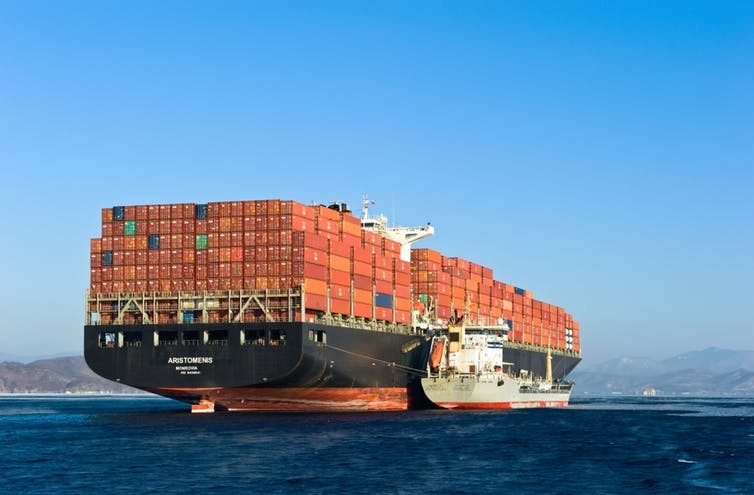Apr 17 2018
A shipping sector summit has been investigating the ways of reducing its contribution to the worldwide greenhouse gas emissions in accordance with the Paris Agreement. However, the difficulty in achieving this is not a lack of low carbon technologies.
 A tanker bunkering (refueling) a container ship in Nakhodka, Russia, in February, 2018. (Image credit: Shutterstock/VladSV)
A tanker bunkering (refueling) a container ship in Nakhodka, Russia, in February, 2018. (Image credit: Shutterstock/VladSV)
The 72nd Marine Environment Protection Committee (MEPC) meeting of the International Maritime Organization (IMO) began in London and proved to be a promising, but contentious, gathering as the sector frantically attempted to comply with an approach for decreasing emissions.
The sector has reacted to this challenge with varying levels of enthusiasm. The Marshall Islands demanded a 100% reduction in emissions by the year 2035. A group of countries (such as India and Saudi Arabia) advocated for no absolute cap on emissions. The European Union demanded a reduction of 70%–100% by the year 2050. It looks probable that an approach to achieve a 50% cut from the 2008 levels by the year 2050 will be the agreed result. Many were of the opinion that this shows inadequate progress.
Previous analysis shows that substantial reductions in emissions within the sector will be highly difficult to accomplish if basic-level changes are not achieved in the short term.
Some Options on the Table
Therefore, how can the sector quickly cut its emissions in the short term? Several technical measures and operational enhancements are already being examined in academia and industry. Below mentioned are five feasible options, which are not essentially mutually exclusive but could assist the industry in reducing the emissions.
- Incremental measures (chiefly short term) which would lead to limited disruption in the sector, but could minimize the emissions per vessel by nearly 5%. These include propeller optimization, enhancing hull design, and recovery of waste heat.
- Operational measures such as slow steaming (ships are operated at low speeds, thereby considerably minimizing their fuel consumption) and route optimization.
- The use of renewable energy—specifically wind-assist, or wind power, for propulsion. Examples include the study performed by Cargill and Wessels in trialing kite systems and the experience of Norsepower and Enercon in installing distinctive rotor designs on ships.
- Switching over to lower carbon fuels for propulsion.
- Storage of energy by using cold ironing (or the supply of shoreside electrical power to a ship at berth when its main and auxiliary engines are turned off) and batteries. This would allow the sector to decarbonize by enabling it to operate with the help of electricity generated using a low carbon grid.
Fuel Choice is Key
The most intensively discussed measure from all the above is unquestionably the choice of fuel used on the ships themselves. Since climate change has a firm place on the agenda and taken into account the historic legacy related to the use of heavy fuel oil with high sulfur content, the industry is at a crucial point in relation to fuel choices in the future.
Regulation with respect to the use of local pollutants indicates that the future use of heavy fuel oil is groundless. The topic of sulfur limits in shipping fuels is also under discussion separately at MEPC. Moreover, current attempts taken at MEPC to initiate more strict measures on climate change indicate that liquefied natural gas (LNG), diesel, and heavy fuel oil are not sustainable. This is in spite of the fact that many in the industry consider LNG to be as the most sustainable fuel to deliver on both these objectives.
In order to gain insights into the complete magnitude of the environmental inferences, it would be significant to take into account the emissions over the entire lifecycle and not merely during fuel combustion. Such “upstream” emissions include those related to growing and/or manufacturing, distribution, use, and disposal of a shipping substitutive fuel. If these wider emissions are not taken into account, the sector and policy on the true emission penalties of any substitutive fuels might be misled.
A study performed by Tyndall Manchester has assessed the operational and upstream greenhouse gas and local pollutant emissions related to traditional fuels as against a broad range of substitutive fuels up to the year 2050. The fuels evaluated are LNG, bio-LNG, biodiesel, heavy fuel oil, straight vegetable oil, diesel, methanol, hydrogen (with and without carbon capture and storage), and renewable hydrogen.
In spite of the probability of a weaker-than-expected agreement on greenhouse gas emissions at MEPC, this study still shows that there is no extensively available fuel to deliver on the motivation of low carbon as well as low local pollutants. Hence, the end results for the sector are in contrast to its existing direction of travel toward investing in LNG.
In case the sector looks forward to using hydrogen or other synthetic fuels, it would have to depend more on the decarbonization of the energy input needed for fuel production to make sure it can achieve absolute cuts in greenhouse gas emissions. It would also require the extensive adoption of carbon capture and storage, which is not commercially viable. In the same way, bio-derived fuels could prove to be an abatement option, however only upon ensuring that upstream emissions—specifically land use change for growing biomass—do not affect wider possible savings.
Therefore, going forward, if the industry desires to deliver on the objectives of MEPC, pivotal obstacles will be the respective fuel life cycles. The approach for overcoming these obstacles might be over and above the scope of the shipping sector alone.
Since the emergent requirement of reducing greenhouse gas emissions is the more difficult problem at hand, care must be exercised to make sure that any short-term measure does not lessen the probable roll-out of low carbon fuels, specifically considering the long lifetimes of ships and fuel supply infrastructure. In order to satisfy the aspiration of cutting down on the greenhouse gas emissions, whole lifecycle emissions must be considered.